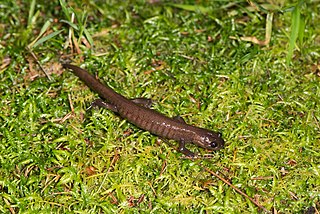
The Asiatic salamanders are primitive salamanders found all over Asia, and in European Russia. They are closely related to the giant salamanders, with which they form the suborder Cryptobranchoidea. About half of hynobiids currently described are endemic to Japan.

Hynobius yangi, the Kori salamander, is a species of salamander endemic to southeastern South Korea. It is a lentic-breeding species similar to the Korean salamander but is distinguished by factors including tail shape and dorsal coloration. The species is known from the vicinity of the type locality in Gijang County in northeastern Busan and from the nearby Ulju County in western Ulsan.

The Abe's salamander is a species of salamander in the family Hynobiidae. It is endemic to Japan and known from southwestern Honshu in northern parts of the Fukui, Kyoto, and Hyōgo Prefectures. The specific name abei honours professor Yoshio Abe, a Japanese zoologist.

Hynobius is a genus of salamander in the family Hynobiidae, occurring in Japan, Korea, China, Taiwan and Far East Russia.

Hynobius arisanensis, the Alishan salamander, is a species of salamander in the family Hynobiidae endemic to Taiwan. It occurs in the Alishan Range, the Yushan Range, and southern Central Mountain Range, where it lives at altitudes of 1,800–3,600 m (5,900–11,800 ft) above sea level. Its natural habitats are temperate forests, rivers, and freshwater springs. It is usually hiding during day time.

Hynobius formosanus, the Taiwan salamander, is a species of salamander in the family Hynobiidae, endemic to Taiwan, where it occurs in the high mountains at around 2,100 m (6,900 ft). Its natural habitats are from open alpine habitats to shaded moist evergreen forests. Adults have a total length of 58–98 mm (2.3–3.9 in).
The Hakuba salamander or Japanese mountain salamander is a species of salamander in the family Hynobiidae. This salamander is also synonymous with the mountain salamander. It is endemic to Japan. Its natural habitats are temperate forests, rivers, swamps, freshwater springs, and plantations. It is threatened by habitat loss.

The Hida salamander or Hondo salamander is a species of salamander in the family Hynobiidae, the Asiatic salamanders. It is endemic to central and western Honshu, Japan. It lives in deciduous, coniferous, and mixed forests, where it breeds in streams. The egg sacs of this species were reported to display blue-to-yellow iridescent glow due to a quasi-periodic diffraction grating structure embedded within the enveloppes of the egg sacs. These salamanders typically spawn from February to April, leading some to metamorphose in late September while others wait for the following year to do so after winter is over.
Hynobius naevius, also known as the spotted salamander, Sagami salamander, Japanese salamander, and blotched salamander, is a species of salamander in the family Hynobiidae. It is endemic to northwestern Kyushu, Japan. Earlier records from Honshu represent other species.

The Ezo salamander, also known as the Hokkaido salamander, Noboribetsu salamander, or Ezo Sanshouo in Japanese is a species of salamander in the family Hynobiidae. Prior to 1923 the species was also classified by the binomial scientific name Satobius retardatus. H. retardatus is endemic to Japan's northernmost prefecture, the island of Hokkaido. The species is a pond-type salamander, and its natural habitats are temperate forests, temperate shrubland, swamps, freshwater marshes, intermittent freshwater marshes, freshwater springs, irrigated land, canals, and ditches.

Hynobius sonani, the Taichū salamander, is a species of salamander in the family Hynobiidae, endemic to Taiwan, where it occurs in the Central Mountain Range above 2,750 m (9,020 ft). Its natural habitats are from open alpine habitats to shaded moist evergreen forests; it breeds in streams.
The amber salamander, amber-colored salamander, tortoiseshell salamander, or Stejneger's oriental salamander is a species of salamander in the family Hynobiidae, endemic to Japan. Its natural habitats are temperate forests and rivers. It is threatened by habitat loss.

The Tokyo salamander is a species of salamander in the family Hynobiidae, endemic to Japan. Its natural habitats are temperate forests, freshwater springs, arable land, irrigated land, and canals and ditches. It is threatened by habitat loss. Many different species of amphibian have unbalanced sex ratios. This trend is no different in Hynobius Tokyoensis; the sex ratio between males and females is about 1.5:1. Although this does not play as large of a role as habitat destruction when it comes to the decline of this species, it is still significant. Considering their environmental preferences, they are usually found in paddy fields. Mid-Summer drainage from these fields hinders the population's ability to thrive as this would occur before these populations could complete metamorphosis.
Hynobius yiwuensis, the Yiwu salamander, is a species of salamander in the family Hynobiidae, endemic to Zhejiang, China. Its distribution area is central and eastern Zhejiang, and includes Yiwu that has given it its name. Its natural habitats are subtropical moist lowland forests, rivers, freshwater marshes, intermittent freshwater marshes, arable land, and rural gardens. The Yiwu salamander is threatened by habitat loss.

Mount Nanhu is a mountain in Taroko National Park, Heping District, Taichung, Taiwan with an elevation of 3,742 m (12,277 ft). It is the 5th highest mountain in Taiwan.

Hynobius fucus is anendemic species of Taiwan, which is mainly distributed around the northwest mountain range, approximately an altitude of 1500 meters. It is one of Taiwan’s amphibian most recently discovered amphibians, as well having the lowest altitude habitat of all of Taiwan’s salamanders. Their main feature is that their body is covered in small blue and white dots. The cloaca is 5cm and body length 8cm. It only has 4 toes in the front and back limbs. Only theTaiwan Hynobius formosanus has the same number of toes as this species. The other types of salamander, including Hynobius arisanensis Maki, Hynobius sonani, and Hynobius glacialis have 5 toes in the hind limbs. This is the one of main methods to differentiate between types of salamander. Currently, the Hynobius fucus is listed as class 1 protected species.

Hynobius fossigenus is a species of salamander in the family Hynobiidae, and is found in some prefectures in Kantō and Chūbu districts in Japan.










